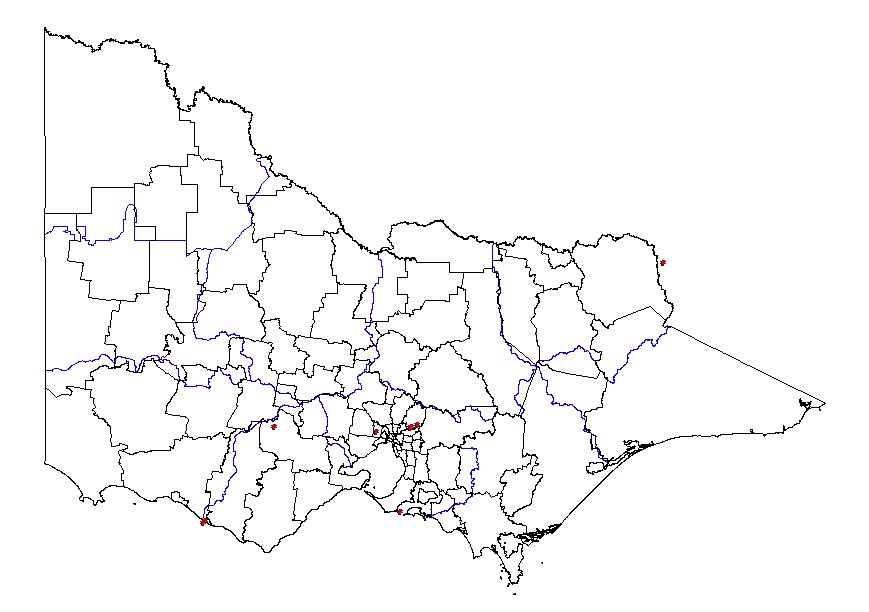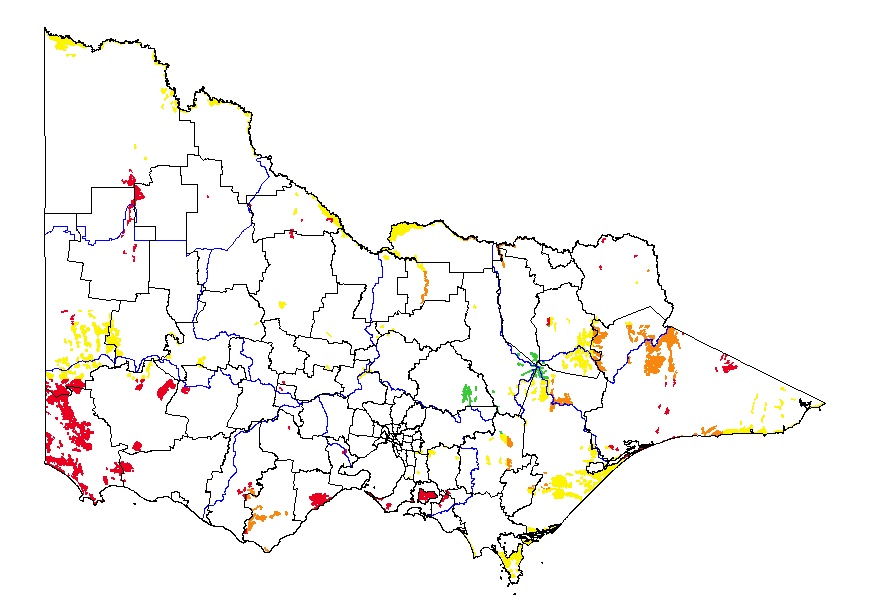Red Hot Poker (Kniphofia uvaria)
Present distribution
|  Map showing the present distribution of this weed. | ||||
| Habitat: Carr et al (1992) reports the species able to invade Dry coastal vegetation, heath and heathy woodland. In Victoria it has naturalised in rear-dune swales on the west coast of Phillip island (eds. Walsh & Entwisle 1994). In California it has been reported to occur in chaparral (heath) and in the grassy edge of a stand of oaks (Calflora 2007). In its native range of Sth Africa it is reported to occur in areas of marsh, riparian areas in fynbos (heath), and moist grassland to more than 1800m (Codd 1968). | |||||
Potential distribution
Potential distribution produced from CLIMATE modelling refined by applying suitable landuse and vegetation type overlays with CMA boundaries
| Map Overlays Used Land Use: Broad vegetation types Coastal scrubs and grassland; coastal grassy woodland; heathy woodland; heath; swamp scrub; sedge rich woodland; sub-alpine woodland; herb-rich woodland; sub-alpine grassy woodland; montane grassy woodland; riverine grassy woodland; riparian forest Colours indicate possibility of Kniphofia uvaria infesting these areas. In the non-coloured areas the plant is unlikely to establish as the climate, soil or landuse is not presently suitable. | 
|
Impact
QUESTION | COMMENTS | RATING | CONFIDENCE |
| Social | |||
| 1. Restrict human access? | Can grow in riparian areas, however only grows to 120 cm and the leaves only have minor serrations (Codd 1968). Therefore only has minimal nuisance factor. | l | mh |
| 2. Reduce tourism? | Ornamental species may alter the aesthetics. | ml | l |
| 3. Injurious to people? | Leaves only have minor serrations (Codd 1968). Grown as a garden plant and has no injuries reported. | l | mh |
| 4. Damage to cultural sites? | Ornamental species may alter the aesthetics. | ml | l |
| Abiotic | |||
| 5. Impact flow? | While it has been reported to grow in marshy places and riparian areas (Codd 1968). It is not reported in areas of flowing water, therefore could have little impact on flow. | l | mh |
| 6. Impact water quality? | Reported in riparian and marshy areas (Codd 1968). No evidence however of the species effecting water quality. | l | mh |
| 7. Increase soil erosion? | Has a spreading rhizomatous root system (eds. Walsh & Entwisle 1994). Therefore presumed to have little impact on erosion processes, and areas invaded only moderate probability of large scale soil movement. | ml | m |
| 8. Reduce biomass? | Not reported to significantly impact on vegetation, fore example preventing regeneration, or altering the habitat. At most presumed replacement of biomass through normal competition. | ml | m |
| 9. Change fire regime? | Reported to respond to fire, (increased flowing) (Codd 1968). No evidence reported of the species altering the fire regime of an area. | l | m |
| Community Habitat | |||
| 10. Impact on composition (a) high value EVC | EVC= Damp Sands Herb-rich Woodland (V); CMA= Glenelg Hopkins; Bioreg= Glenelg Plain; VH CLIMATE potential. Reported to occur in small groups (Codd 1968). No reported displacement of any indicator species, therefore low impact. | l | m |
| (b) medium value EVC | EVC= Damp Heathland (D); CMA= Glenelg Hopkins; Bioreg= Glenelg Plain; VH CLIMATE potential. Reported to occur in small groups (Codd 1968). No reported displacement of any indicator species, therefore low impact. | l | m |
| (c) low value EVC | EVC= Coastal Dune Scrub (LC); CMA= Glenelg Hopkins; Bioreg= Glenelg Plain; VH CLIMATE potential. Reported to occur in small groups (Codd 1968). No reported displacement of any indicator species, therefore low impact. | l | m |
| 11. Impact on structure? | Reported to occur in small groups (Codd 1968). No reported displacement of any indicator species or the species impacting upon ecosystem process, such as regeneration. | l | mh |
| 12. Effect on threatened flora? | No evidence of this reported. | mh | l |
| Fauna | |||
| 13. Effect on threatened fauna? | No evidence of this reported. | mh | l |
| 14. Effect on non-threatened fauna? | Very little impact, as invaded habitats not reported to be significantly changed. | ml | l |
| 15. Benefits fauna? | Produces nectar for bird and insect species (Dave’s Garden 2007). | mh | ml |
| 16. Injurious to fauna? | No evidence of this reported. | l | l |
| Pest Animal | |||
| 17. Food source to pests? | Visited by bees (Dave’s Garden 2007). | ml | ml |
| 18. Provides harbor? | Tufted herb only growing to 1.5m (eds. Walsh & Entwisle 1994). Therefore limited opportunity for long term shelter. May provide some small amount of short term harbour. | ml | l |
| Agriculture | |||
| 19. Impact yield? | Not an agricultural weed. | l | m |
| 20. Impact quality? | Not an agricultural weed. | l | m |
| 21. Affect land value? | Not an agricultural weed. | l | m |
| 22. Change land use? | Not an agricultural weed. | l | m |
| 23. Increase harvest costs? | Not an agricultural weed. | l | m |
| 24. Disease host/vector? | Not an agricultural weed. | l | m |
Invasive
QUESTION | COMMENTS | RATING | CONFIDENCE |
| Establishment | |||
| 1. Germination requirements? | Recommendations for propagation in spring, suggest a focus on germination at the start of the growing season (PFAF 2002). Unknown however natural requirements. | mh | m |
| 2. Establishment requirements? | Unknown specific natural requirements; however has been described as being intolerant of shade (PFAF 2002). This is backed up by descriptions of habitat where it invades or is present being more open systems, grasslands and heathland (Codd 1968). | m | m |
| 3. How much disturbance is required? | Carr et al (1992) reports this species being able to invade heath land and heathy woodland. While Codd (1968) restricts its presence in its natural range to riparian areas with in heathland along with other habitats, including moist grassland to over 1800m, which would be an alpine ecosystem. This suggests that the species can at least in some capacity invade areas which have been categorised as undisturbed ecosystems. | h | mh |
| Growth/Competitive | |||
| 4. Life form? | Rhizomatous herb (eds. Walsh & Entwisle 1994). | ml | mh |
| 5. Allelopathic properties? | No evidence of this described. | l | m |
| 6. Tolerates herb pressure? | It is reported to be rarely eaten by deer or rabbits (PFAF 2002). Therefore presumed other grazing species would also avoid it. | mh | m |
| 7. Normal growth rate? | Reported as being fast growing in a garden situation, but not to the extent that it then causes problems (Dave’s Garden 2007). Therefore presumed to have a competitive growth rate. | mh | m |
| 8. Stress tolerance to frost, drought, w/logg, sal. etc? | Tolerant of maritime exposure, has established in dune systems of Phillip island (PFAF 2002; eds. Walsh & Entwisle 1994). Frost tolerant rated to -23C (Dave’s Garden 2007). Tolerant of waterlogging, described in marshy places (Codd 1968). Reported to flower profusely after fires (Codd 1968) | mh | mh |
| Reproduction | |||
| 9. Reproductive system | Produces seed and spreads by rhizomes (eds. Walsh & Entwisle 1994). | h | mh |
| 10. Number of propagules produced? | Produces numerous seeds (eds. Walsh & Entwisle 1994). Therefore presumed average of more than 1000 per plant. | mh | m |
| 11. Propagule longevity? | Unknown: Reported to usually germinate within 2 months of sowing (PFAF 2002). If seed is cleaned it can be stored (Dave’s Garden 2007). | m | l |
| 12. Reproductive period? | Plants in a garden situation and on a roadside (presumably the result of dumping garden material) have been observed to persist for more than 10 years (Mitchard pers com). | h | ml |
| 13. Time to reproductive maturity? | Vegetative propagules can flower the first year after they are planted (Dave’s garden 2007). Therefore presumed under natural conditions plants can reach maturity within 1-2 years. | mh | ml |
| Dispersal | |||
| 14. Number of mechanisms? | 3 mm long seeds, dispersed by wind (Carr, Yugovic and Robinson 1992; eds. Walsh & Entwisle 1994). | h | mh |
| 15. How far do they disperse? | Unknown exactly, however has small seeds which are dispersed by wind, however they don’t have any specialised structures to aid this (Carr, Yugovic and Robinson 1992; eds. Walsh & Entwisle 1994). Therefore presumed seeds capable of dispersing to a distance in the range of 200 m-1 km. | mh | m |
References
Calflora: Information on California plants for education, research and conservation. [web application]. 2007. Berkeley, California: The Calflora Database [a non-profit organization] viewed 12 Jan 2007, http://www.calflora.org/ .
Carr G.W., Yugovic J.V. and Robinson K.E., 1992, Environmental weed invasions in Victoria: conservation and management implications, Department of Conservation and Environment, Clifton Hill.
Codd L.E., 1968, The South African Species of Kniphofia. Bothalia Vol 9, parts 3 and 4. Botanical Research Institute.
Dave’s Garden: Dave’s Garden “For Gardeners… By Gardeners”. viewed 17 Jan 2007, http://davesgarden.com/
Mitchard, B. Research Assistant, Weed Risk Assessment Team. DPI, Frankston. Tel 9785 0111. (17/01/07)
PFAF: Plants for a Future. Edible, medicinal and useful plants for a healthier world. viewed 8 Dec 2002, http://pfaf.org/
Walsh N. and Entwistle, T. (eds) 1994, Flora of Victoria: volume 2, ferns and allied plants, conifers and monocotyledons, Inkata Press, Melbourne.
Global present distribution data references
Australian National Herbarium (ANH) 2007, Australia’s Virtual Herbarium, Australian National Herbarium, Centre for Plant Diversity and Research, viewed 12 Jan 2007 ,http://www.anbg.gov.au/avh/
Calflora: Information on California plants for education, research and conservation. [web application]. 2007. Berkeley, California: The Calflora Database [a non-profit organization] viewed 12 Jan 2007, http://www.calflora.org/ .
Department of Sustainability and Environment (DSE) 2006, Flora information system (FIS) [CD-ROM], Biodiversity and Natural Resources Section, Viridans Pty Ltd, Bentleigh.
Global Biodiversity Information Facility (GBIF) 2007, Global biodiversity information facility: Prototype data portal, viewed 12 Jan 2007, http://www.gbif.org/
Missouri Botanical Gardens (MBG) 2007, w3TROPICOS, Missouri Botanical Gardens Database, viewed 12 Jan 2007, http://mobot.mobot.org/W3T/Search/vast.html
Feedback
Do you have additional information about this plant that will improve the quality of the assessment?
If so, we would value your contribution. Click on the link to go to the feedback form.


